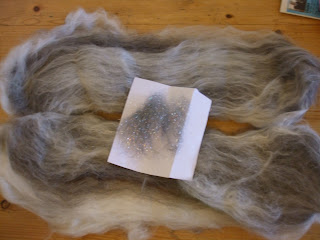Anyone who has been a knitter or spinner in the last few years can hardly fail to have noticed the popularity of multicoloured yarns, and fibres. From subtle shading to vibrant contrasts, there's a wealth of variegation out there! Deliciously colourful skeins of yarn or tops and batts ready for spinning are very tempting, and the changes of colour add another layer of interest while we're working with the yarn or fibre, but the finished results are usually very different from the 'package' that tempted us so much .
 |
| singles |
 |
| 2-ply |
 |
| navajo-plied |
In the second top the colours are blended along the length of the top - it is a mixture of merino and silk (from Ashfords I think!). You can see that (on the bobbins) in the singles yarn the colour is already more evenly blended
Once the yarn has been plied and knitted the colour is fairly homogenous while retaining some subtle variegation and occasional highlights of silk (ignore the 2-colour knitting in the top left of the photo)
 The third example is a hand-blended drum-carded batt - a mixture of various black and white wools (with a little sparkle, on the envelope, still to be added). So again the streaks of colour are along the length of the batt, built up in layers.
The third example is a hand-blended drum-carded batt - a mixture of various black and white wools (with a little sparkle, on the envelope, still to be added). So again the streaks of colour are along the length of the batt, built up in layers. |
| singles |
The black and white yarn was intended for use as singles, to avoid further mixing of the colours. Any 'barber's pole' areas are where two colors of fibre are spun together without being blended. In order to 'set' the active twist the yarn had to be steamed and then dried under tension. The cowl that it was knitted into was worked in the round so that any remining singles slant, which will probably re-assert itself after washing, will have less effect.
Spinning technique
All three yarns were spun in semi-worsted style - in the same direction as the fibres were lying in the top/batt. I broke the tops into 20 - 30 cm lengths, slightly extended each one lengthwise to straighten the fibres, and then started spinning from the end. I didn't split the tops down their length or predraft as I find both of these techniques are usually not helpful, but doing so might have affected the way in which the colours were mixed. I did divide the batt lengthwise into a number of strips before spinning from the end of the strip.
Spinning 'from the fold' - effectively dafting at right angles to the fibre length while holding the fibres folded over the index finger - would have mixed up the colours more, especially in the case of the carded batt.
The effect of plying
The merino-blend yarns were 2- plied, which further mixed the colours and where there was a lot of colour variation in the singles (the pink yarn) this led to a lot of 'barber's pole' areas. Plying a variagated single with a solid colour single can give more distinct colour variations in the finished yarn especially if the shade of the solid colour single is close to one of the shades in the varigated one. Alternatively if a completely different colour is chosen, a 'barber's pole' with one colour varying is the result :







No comments:
Post a Comment